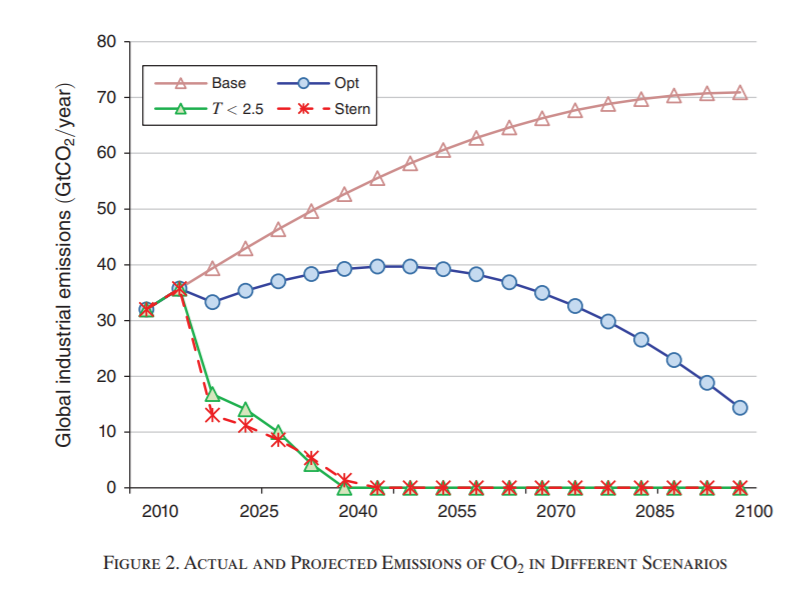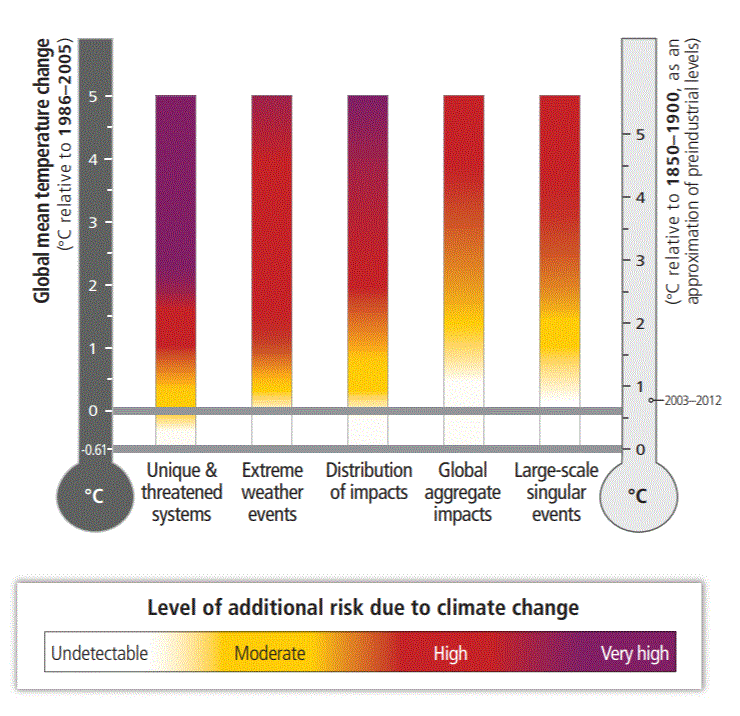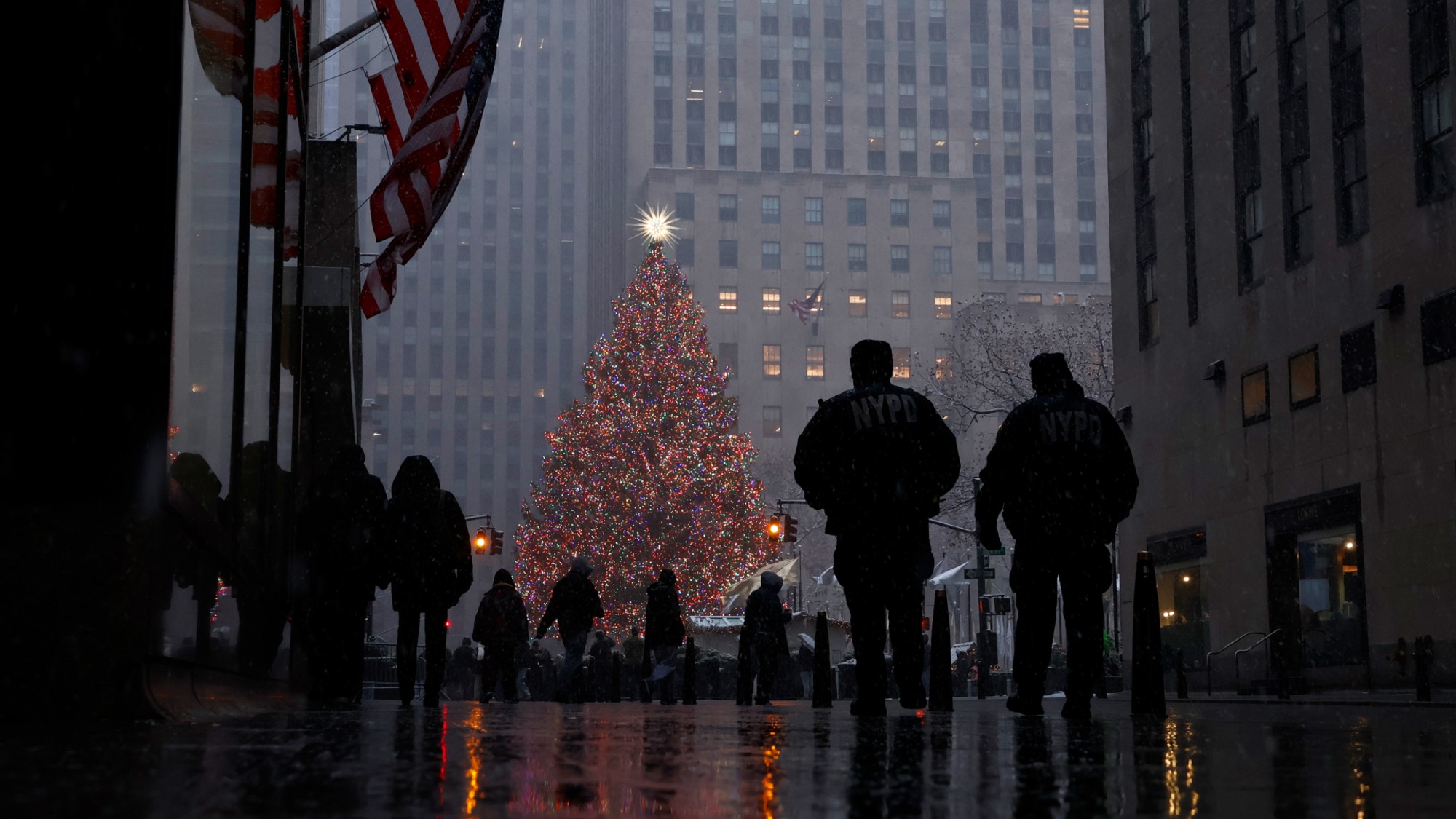The deadly hidden risks within the most prominent economic model of climate change
Global warming is an emergency, not a trifle to be dealt with decades hence


Is climate change a crisis demanding immediate aggressive action to smash down carbon emissions, or is it an annoying inconvenience that can be dealt with slowly over decades?
Most climate scientists are in the former camp — as shown in the recent Intergovernmental Panel on Climate Change (IPCC) report advocating for an eye-watering 50-percent cut in emissions by 2030. But many economists are in the latter camp, taking a relatively cavalier attitude about climate change. They have built models showing the economic damage of warming will not be that great, or that the costs of mitigation could be even greater, and therefore we shouldn't be too aggressive in keeping emissions down — which could be even worse than doing nothing, by their lights. As a result, they generally serve to advance policy responses centered around putting a price on carbon, or, in other words, using market mechanisms to gradually wean our existing economic structures off fossil fuels, but foregoing any sort of massive intervention that would disrupt the status quo.
These models, however, have some hellishly risky assumptions buried deep in their guts. If we take the economists' advice, we will be taking a terrific gamble with all of human society.
The Week
Escape your echo chamber. Get the facts behind the news, plus analysis from multiple perspectives.

Sign up for The Week's Free Newsletters
From our morning news briefing to a weekly Good News Newsletter, get the best of The Week delivered directly to your inbox.
From our morning news briefing to a weekly Good News Newsletter, get the best of The Week delivered directly to your inbox.
***
The most prominent of these economists is certainly Professor William Nordhaus of Yale, who won the 2018 Nobel Memorial Prize in economics for his work constructing the most famous economic model of climate change. It's called the Dynamic Integrated Model of Climate and the Economy, or DICE, and it attempts to account for the interactions of labor, capital, interest rates, etc., in a warming climate.
Think tanks have pointed to Nordhaus' research as justification for a moderate carbon tax, for which he is probably the most influential proponent in the world. His work has been used by government departments around the world, including the U.S. Environmental Protection Agency, to inform their research and policy thinking. The United Nations recently released a report calling for a stiff price on carbon heavily influenced by his work. Both British Columbia in Canada and Singapore have actually adopted his ideas directly, while California and the European Union have carried out somewhat similar efforts to put a price on carbon with cap-and-trade systems.
A carbon tax is certainly better than nothing, but as yet none of these policies have made a real dent in emissions on their own. Worse, anti-climate policy voices like Bjorn Lomborg and Oren Cass have pointed to Nordhaus' estimates as justification for doing little or nothing about climate change.
A free daily email with the biggest news stories of the day – and the best features from TheWeek.com
There is a lot going on in the DICE model, but at bottom it relies on three interlocking mechanisms. First is a prediction of the future trend of economic growth coming from the conservative "neoclassical" school; second, how much climate mitigation to cut emissions will cost; and third, how much climate damages will cost. Combine those together with an estimate of the "discount rate" (that is, how much less we should value the future economy compared to the present), and you get a "social cost of carbon" — what carbon dioxide emissions costs world civilization ($31 per ton in 2010 dollars), which then can be canceled out with a carbon tax paid by polluters.
From there, you can solve for the "optimal" future climate policy — that is, the emissions pathway that will maximize economic welfare over future time.
Neoclassical models assume that the long-term trajectory of economic growth is fixed, depending only on how much capital (that is, factories, tools, housing, and so on) a society accumulates. That in turn implies that any climate investment must harm the economy, because it diverts from producing actual growth-producing capital. If you cut emissions too fast, you harm growth and thus society. But cut them too slow, and climate damages will outweigh the benefit of not having to cut back. Nordhaus thus comes up with a Goldilocks trajectory where emissions peak at about 2050 and thereafter decline slowly, reaching about 15 million metric tons per year by 2100. Here the pink line is a "business as usual scenario," the blue is Nordhaus' optimal path, and the red is an aggressive emissions reduction pathway.

Following Nordhaus' "optimal" path, carbon dioxide concentrations would approach 650 parts per million by the end of the century, or about 2.5 times the pre-industrial figure, and the average atmospheric temperature would be about 3.5 degrees Celsius higher. To get a sense for what that means, the IPCC's 2014 report contains the following chart illustrating the magnitude of risks in a variety of areas.

The report says reaching just 4 degrees of warming (or just half a degree above Nordhaus' Goldilocks scenario for 2100, which would be quickly reached in the following decades), would "include severe and widespread impacts on unique and threatened systems, substantial species extinction, large risks to global and regional food security, and the combination of high temperature and humidity compromising normal human activities, including growing food or working outdoors in some areas for parts of the year."
So how can Nordhaus propose an "optimal" climate future is one which might compromise such seemingly-important activities like "growing food or working outdoors"? Let's dig in.
***
One could begin by attacking the neoclassical aspect of Nordhaus' model (and I will later), but there are bigger problems. The first one is the model's "damage function," which estimates the cost of climate change effects. In the most recent DICE revision, Nordhaus basically combined lots of different studies of damage estimates at different temperatures into a chart that could then be used to plot a trend line, akin to how someone might suss out the effect of Miracle-Gro by plotting a chart of plant heights with different amounts of fertilizer added. He then added 25 percent to account for damages not included in the various estimates, and thus got an equation that will pop out economic damages at any level of warming. Plug in the degrees of warming, and receive the percent of GDP that is lost due to extreme weather, rising seas, and so forth.
The biggest problem with this damage function is it rules out any tipping points — that is, the possibility that at a certain point, the economic damage from warming will accelerate dramatically. Nordhaus' function has no such kinks — it is a simple quadratic equation with a smooth curve. "The quadratic form fits better than linear or higher order to the available estimates," he told The Week, meaning a mathematical function with a tipping point didn't fit his data set as well.
To start with, it's important to realize that any estimate of the future costs of climate change are wildly uncertain. Indeed, the costs of climate damages today with just one degree of warming are sharply disputed, in part because there are limited data and confounding factors. Extreme weather events, for instance, are rare and random, so statistics will take time to shake out. Meanwhile richer countries have both greater wealth at risk but better building codes and thus construction that is more resistant to damage.
Thus any estimate about what will happen with high levels of warming is radically uncertain. As the late Harvard economist Martin Weitzman writes, "All damage functions are made up — especially for extreme situations."
This inescapable reality makes the method by which Nordhaus constructs his damage function rather suspect. Typically when one is constructing a trend line, one looks at actual physical measurements. For a breakdown of height distribution, for instance, one writes down the heights of lots and lots of people, plots the data, and then draws a line that fits (a classic "normal" distribution, as it happens).
Nordhaus' damage function trend line, by contrast, is based on (very uncertain) projections, none of which look at warming higher than 6 degrees. Some of the underlying studies do attempt to model various economic sectors from warming, but at bottom the estimates do not show any tipping points because the authors assumed there aren't any. It's a rather shaky foundation for a policy model that purports to show the optimal trajectory of climate emissions for all of human society.
Indeed, Nordhaus himself staples a 25-percent fudge factor onto his original regression to account for the fact that "current studies generally omit several important factors (the economic value of losses from biodiversity, ocean acidification, and political reactions), extreme events (sea-level rise, changes in ocean circulation, and accelerated climate change), impacts that are inherently difficult to model (catastrophic events and very long term warming), and uncertainty (of virtually all components from economic growth to damages)," he writes in his damage function paper. He further admits that 25 percent is "largely a judgmental adjustment." He could have picked 10, 50, or 100 percent with equal justification.
For a concrete example, let's consider what Greenland might do to sea level rise, as Nordhaus does in a recent paper. Mainstream climate science estimates that, while the whole Greenland ice sheet will probably melt if we get past a few degrees of warming and raise ocean levels by about 23.5 feet, it will take thousands of years to happen. Nordhaus concludes it would not add much to his social cost of carbon "because melting is slow and damages are far in the future." (As noted above, even a small discount rate in calculations is going to sharply reduce the apparent cost of damages that happen thousands of years from now.)
However, ice sheet melting is one of the most unsettled parts of climate science, because it is devilishly tricky to figure out what is even going on within ice sheets that are hundreds of meters thick, much less predict how warming is going to affect their deep interiors, how they move across the ground, the rate of icebergs falling into the ocean, and so on. (Indeed, earlier IPCC committees could not agree on what was most likely to happen with ice sheets, so they just left them out entirely, which turned out to be a large mistake.)
What's more, there are some suggestive indicators that Greenland's ice sheet will melt a lot faster than Nordhaus assumes. A 2019 paper on the subject found that melting there accelerated sixfold from 1980-2018, going from a loss of about 51 billion metric tons of ice per year to about 286 billion tons per year. The authors estimated that Greenland contributed 13.7 millimeters to world sea level — and half of that in just the last eight years.
And while the rate of melt acceleration did stop from 2010-18 due to a series of cold summers, this year Greenland has endured two major heat waves (so far) that broke melting records that go back to 1950. First from June 11-20 it experienced an unusual warm spell after a dry spring (which meant little protective snow) and lost about 80 billion metric tons of ice, breaking the record for that period. Then in late July, trapped under a high-pressure heat dome, it broke the all-time record for a single day's melt with 12.5 billion metric tons of ice lost.
Over the whole of July the sheet lost 197 billion metric tons of ice, or enough to raise world sea levels by 0.5 millimeters. That's nearly 4 percent of Greenland's 1980-2018 sea level contribution in just a single month. The whole summer will finish off perhaps 400 billion metric tons of ice, or more. And let's not forget there is another much bigger ice sheet on Antarctica, where the same group of scientists found a similar acceleration in melting since 1980.
A recent study suggested that under a high-emission scenario that drove warming to 5 degrees, sea level would rise by between 62 and 238 centimeters (24-94 inches) by 2100 — and by 2200, by roughly 7.5 meters. Yet the single-day record Greenland set earlier this year is already level with the average daily melt that the most pessimistic model predicts for the year 2070. Of course this year's conditions could be a fluke, but they also suggest a live possibility that Greenland is going to melt even faster than the current worse-case scenario, and boost sea levels accordingly.
If ice sheet melting and sea level rise accelerate sharply past a certain level of warming, that would mean a tipping point for economic damages. But it's also extremely easy to imagine the damage of rising seas hitting a tipping point even if they rise steadily, if it is fast enough. For instance, levels around New York City have risen 6 inches since 1948. The city has not yet needed to build major defensive structures (or abandon big chunks of the city outright), but at some point that will become necessary. A rise of over 2 meters (or nearly 8 feet) would unquestionably either flood hundreds of billions of dollars of the world's most valuable real estate, or require enormously expensive seawalls. The case is even clearer in Miami, where half the population lives at or below 6 feet above sea level, and it would be nearly impossible to build seawalls because the stone underlying the city is so porous.
The cases of low-lying coral atolls (like most of the Marshall Islands) are clearer still. A recent study found that by the middle of this century, most of those atolls will be flooded over with seawater at least once per year, rendering them "uninhabitable" due to infrastructure damage and loss of fresh groundwater. Past a certain point of warming, all the communities on those islands — and all the hundreds of billions of dollars' worth of American military installations on them — will be a total write-off.
It would be very difficult to write down a precise estimate of what it might cost to build big seawalls around major cities very quickly — much less the risk of those walls failing, and what that might cost — or the price of rapidly abandoning ones that simply can't be salvaged. (All this is rendered unnecessary by Nordhaus' belief that melting will only happen very slowly.) But the price would be very large.
Or let's consider agriculture. The effect of warming on farm yields at low temperatures is tricky to figure out, because a slightly warmer climate can help by extending the growing seasons, and more carbon dioxide means more plant food, but on the other hand heat generally stresses plants. At high levels of warming, however, farming will very likely be badly damaged.
For one thing, plants have an ideal temperature range for growth and reproduction. For corn and soybeans, vegetative growth falls off sharply past about 32 degrees Celsius (90 Fahrenheit) — and the plants will not reproduce at all if temperatures surpass 35 or 38 degrees respectively. One study estimated that, holding planting areas constant, U.S. yields of these two crops would fall by 30-46 percent under a low-warming scenario, and 63-82 percent under a high-warming one.
This is why U.S. "hardiness zones," which measure the suitability of land for cultivation of various plant types, have been moving north at about 13 miles per year. Meanwhile, studies suggest that yields of rice (which is a staple food for about half the people on the planet) will fall by about 8 percent for every degree of warming, and wheat yields by 6 percent. As warming increases, it will become impossible to grow traditional crops in vast swathes of agricultural land. Indeed, this phenomenon is a major driver of the Central American refugee crisis, as climate change has destroyed many previously-functional coffee farms in Honduras.
It would be difficult indeed to come up with a comprehensive estimate of damages here. Some might be ameliorated by engineering new plant varieties, or moving cultivation into northern countries like Canada and Russia with giant tracts of taiga and tundra. On the other hand, climate change also means increased flooding (which inundated millions of acres of prime American farmland this year) and drought. What's more, northerly regions of Canada and Russia generally have poor topsoil, because they were repeatedly scraped clean by glaciers during the last ice age (which is what piled up the excellent soil in the American Midwest in the first place). Agriculture might flourish there for a few decades, only for the soil to be depleted.
At a minimum, some kind of tipping point in agriculture looks highly probable, even if it can't yet be precisely measured.
Then let's consider plain old heat. The human body's ability to adapt to high temperatures has limits — beyond a certain point, even a healthy adult sitting in the shade, wrapped in a wet towel, with a heavy wind blowing will still die of heatstroke after a few hours. As Weitzman points out, a paper some years ago found that such a "wet bulb" threshold is about 35 Celsius. That measure didn't exceed 31 Celsius anywhere on Earth at the time, but the authors estimated that at an extreme 12 degrees of warming, the majority of the human population would be living in areas that would exceed 35 Celsius at least once per year. (Another study found that "just" 6 degrees of warming would cut aggregate human capacity for outside manual labor by more than 60 percent.)
Yet Nordhaus' model finds that 12 degrees of warming — when more than half the population would regularly be risking death just by stepping outside — would only cut world GDP by about 34 percent. It just does not pass the smell test. "In my opinion, his quadratic approximation is too sanguine for high temperature changes," Weitzman told The Week last month.
Climate scientist Michael Mann agrees. "There is solid evidence we may already be encountering tipping points, in the melting of the west Antarctic and Greenland ice sheets — and the dramatic acceleration in sea level rise that may bring, to the collapse of the North Atlantic 'conveyor belt' ocean circulation, which now appears to be underway," he told The Week.
***
The second major problem with Nordhaus' model is in its treatment of climate investment. In keeping with his neoclassical growth model, all climate mitigation is assumed to be an economic drain. Government spending on solar panels and such come at the cost of other things that could enhance growth — thus being too aggressive with climate policy can be worse than doing nothing at all, by this view.
A nation threatened with Nazi invasion does not fuss around with aggregate welfare functions.
However, it could quite easily be the opposite. Neoclassical growth models assume that the long-run growth trajectory is fixed — meaning it is immune to government policy. But the last decade has seen a shocking slowing of growth relative to the post-1945 average. After the Great Recession, per capita growth kinked down by about 40 percent, and shows little sign of catching up to the previous trend, despite the reasonably low unemployment rate of late.
As economist J.W. Mason carefully argues, the problem is a lack of government stimulus. The economy has sagged for over a decade — which again, Nordhaus' growth theory says should be impossible — because the state has not dumped spending into the economy to restore employment and production (on the contrary, from 2011-16 it did the opposite). But on the other hand, a crash program to tackle climate change would necessarily involve a ton of government spending.
A Green New Deal would involve massive government investment in clean energy, public transit, electric cars, and so forth, which could undo a great deal of a lingering damage from the Great Recession — effectively paying for itself in part by restoring broader economic strength. (The eurozone is even more starved of stimulus.) Of course, that boost would not last forever. But another recession is coming at some point, in which case it will take another dollop of stimulus to keep the economy pressurized.
The point here is that the neoclassical growth model is not accurate (even if it may be useful in other contexts), and using it in Nordhaus' model here certainly overstates the cost of climate mitigation. The world economy needs regular doses of stimulus, and climate investment could offset much of its own cost by keeping the economy strong.
What's more, there are broader benefits of eradicating fossil-fuel energy. Air pollution (largely the result of coal and automobiles) kills some 4.5 million people around the world every year, while oil, gas, and coal development cause routine disasters. Better health would certainly provide substantial economic benefits in addition to the, you know, people not dying of emphysema and lung cancer thing.
So climate mitigation not only is less expensive than Nordhaus' model makes it out to be, aggressive government spending is very likely necessary to get the consistent growth that his model takes for granted. (When asked about this point, Nordhaus told The Week it was a "good point," but still concluded that "business cycle management is high-frequency policy while climate policy is low-frequency, lower than it should be, but not one that varies tweet by tweet.")
***
The most fundamental objection to the Nordhaus model, however, has to do with uncertainty, which throws his entire style of analysis into question. As the late climate scientist Stephen Schneider writes, considering the future of climate change involves an "uncertainty explosion." First, there is the unknown of how much humans will emit over the coming years, which feeds into uncertainty in how earth's biosphere will deal with all the extra carbon, which feeds into uncertainty over how temperatures will respond to increased carbon dioxide concentration, which feeds into uncertainty over how particular regions will respond (the Arctic, for instance, is warming much faster than the rest of the planet).
All those factors taken together then feed into uncertainty over the total range of possible climate change impacts. It is just wildly impossible to say for sure what will happen — at any given level of warming, we can rule out neither shockingly mild nor shockingly horrible effects. But it is the latter category of unknown-probability, high-impact events that matters for the purposes of policymaking.
For instance, what if the ice sheets on Greenland and Antarctica rapidly collapse, and sea levels around the world suddenly increase very fast? What if warming triggers the rapid release of methane clathrates on the sea floor, and temperature increase accelerates out of control? What if key ecosystems (like the Amazon rainforest, which is currently suffering the worst fires in its history) are pushed beyond their capacity to adapt, and collapse suddenly? What if the Gulf Stream (which keeps Europe several degrees warmer than it would be otherwise) — collapses? What if some ancient pathogens come out of melting permafrost and trigger a global pandemic, or annihilate one of the few staple crop species?
"Highly convex damage functions are a possibility, not near a certainty," according to Nordhaus. Yet these possibilities do not exist in Nordhaus' model, where each degree of warming causes exactly 0.00236(x)2 percent loss in global output per degree x, no matter how high the warming.
From a risk management perspective, it is the height of irresponsibility not to consider the possibility of these disasters, even if they can't be exactly quantified. Consider an analogy. Suppose someone offers you a lot of money to play a game of Russian Roulette, but will not divulge how many of the chambers in the revolver are loaded, if any — thus making it impossible to calculate the probability of blowing your brains out. It doesn't take a genius to see how that might be a bad idea to play even if you can't write down any aggregate welfare equations describing the game. Following Nordhaus' advice to rely on just a $31-per-ton carbon tax would be effectively playing such a game.
Indeed, political leaders often have to face possibly-devastating events, the precise likelihood of which cannot be calculated. As such an event seems more possible, nations rationally undertake more and more extreme measures to head it off, or prepare for it. For instance, in the late 1930s Franklin Roosevelt did not know the precise risk of becoming embroiled in a war with Imperial Japan and Nazi Germany, yet directed enormous resources towards preparing for that possibility — quite wisely, as it turned out.
It's amusing to imagine the DICE approach applied to war planning in 1941. You'd estimate how formidable Japan and Germany were, calculate the minimum necessary force to defeat them (with a 25-percent margin of error), and produce only that much war materiel. Wouldn't want to produce too many tanks and airplanes and knock a few points off your neoclassical aggregate welfare function by having to raise taxes more than necessary!
Silliness aside, this analogy makes the failure of risk analysis plain. If national war planners had overestimated the strength of the enemy in 1941 and built too many tanks, then America would have had minor problems of over-taxation and a postwar scrap pile. If they had underestimated the enemy and built too few, then the U.S. might have been conquered by Hitler. That is why a nation threatened with Nazi invasion does not fuss around with aggregate welfare functions. Instead it wrings the maximum possible amount of troops, tanks, airplanes, and so on out of itself.
Now, to be fair, Nordhaus is no climate denier. He does support a carbon tax, and in recent work has expressed increasing alarm at the total lack of serious, coordinated climate policy across the world. But his model is both extremely casual about running some truly eye-popping risks, and far too skeptical of the benefits of strong climate policy. His classic economist-style approach is simply a poor guide for a problem like climate change. And it gives license and validation to individuals or governments who are reluctant to pursue serious climate policy.
An unknowable, very possibly existential risk demands more than trying to calculate the very cheapest possible solution.
Editor's note: This piece has been updated to reflect the news of Martin Weitzman's death. He spoke to The Week for this piece prior to his passing.
Want more essential commentary and analysis like this delivered straight to your inbox? Sign up for The Week's "Today's best articles" newsletter here.
Ryan Cooper is a national correspondent at TheWeek.com. His work has appeared in the Washington Monthly, The New Republic, and the Washington Post.
-
 How climate change is affecting Christmas
How climate change is affecting ChristmasThe Explainer There may be a slim chance of future white Christmases
-
 The MAGA civil war takes center stage at the Turning Point USA conference
The MAGA civil war takes center stage at the Turning Point USA conferenceIN THE SPOTLIGHT ‘Americafest 2025’ was a who’s who of right-wing heavyweights eager to settle scores and lay claim to the future of MAGA
-
 The 8 best drama movies of 2025
The 8 best drama movies of 2025the week recommends Nuclear war, dictatorship and the summer of 2020 highlight the most important and memorable films of 2025
-
 Has Zohran Mamdani shown the Democrats how to win again?
Has Zohran Mamdani shown the Democrats how to win again?Today’s Big Question New York City mayoral election touted as victory for left-wing populists but moderate centrist wins elsewhere present more complex path for Democratic Party
-
 Millions turn out for anti-Trump ‘No Kings’ rallies
Millions turn out for anti-Trump ‘No Kings’ ralliesSpeed Read An estimated 7 million people participated, 2 million more than at the first ‘No Kings’ protest in June
-
 Ghislaine Maxwell: angling for a Trump pardon
Ghislaine Maxwell: angling for a Trump pardonTalking Point Convicted sex trafficker's testimony could shed new light on president's links to Jeffrey Epstein
-
 The last words and final moments of 40 presidents
The last words and final moments of 40 presidentsThe Explainer Some are eloquent quotes worthy of the holders of the highest office in the nation, and others... aren't
-
 The JFK files: the truth at last?
The JFK files: the truth at last?In The Spotlight More than 64,000 previously classified documents relating the 1963 assassination of John F. Kennedy have been released by the Trump administration
-
 'Seriously, not literally': how should the world take Donald Trump?
'Seriously, not literally': how should the world take Donald Trump?Today's big question White House rhetoric and reality look likely to become increasingly blurred
-
 Will Trump's 'madman' strategy pay off?
Will Trump's 'madman' strategy pay off?Today's Big Question Incoming US president likes to seem unpredictable but, this time round, world leaders could be wise to his playbook
-
 Democrats vs. Republicans: who are US billionaires backing?
Democrats vs. Republicans: who are US billionaires backing?The Explainer Younger tech titans join 'boys' club throwing money and support' behind President Trump, while older plutocrats quietly rebuke new administration
